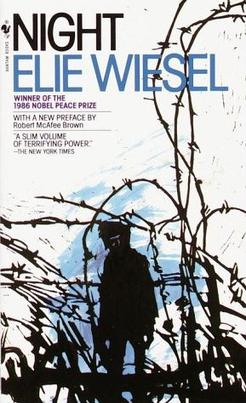by Elie Wiesel
New York: Hill and Wang, 1972 (originally published in the United States in 1958)
Audience: Grade 7+
Audience: Grade 7+
Eliezer “Elie” Wiesel is a 15-year-old Orthodox Jew living in Sighet, Hungary in 1943. Elie spends most of his time studying the Talmud and discussing life and religion with his synagogue’s caretaker, Moshe the Beadle. Soon, the government begins to take a new stance on Jews living in Hungary. Moshe the Beadle is forced onto a cattle train and taken to Poland, only to escape, returning to Sighet to warn the Jews of the horrors he witnessed at the hands of the Gestapo.
Over the following months, Elie and his family are forced by the German SS to move to a ghetto adjacent to their town. There they live, unsure of their fate, until May 1944 when they are told they are being relocated. Elie and his family board a crowded cattle train and are taken to the concentration camp of Auschwitz-Birkenau. Upon arriving at Auschwitz, Elie and his father, Shlomo, are separated from his mother and sisters, who are immediately killed. Elie and Shlomo struggle to survive in the horrifying conditions of Auschwitz-Birkenau and the eventual death march they are forced to undertake as their captors evade the Allied forces.
 |
| Buchenwald Liberation |
This beautifully written and heart-wrenching story is a must-read for anyone wishing to come to a better understanding of the horrors of the holocaust. Wiesel’s experiences are unimaginable, particularly because he was just a teenager while battling for his life. Night also manages to express the terrible events in the story without graphic language or gore, making it appropriate for younger audiences.
An appropriate continuation for students interested in learning more about Elie Wiesel and his incredible life would be to read the “sequels” to Night, Dawn (1961) and Day (1962). Students can also learn more about Wiesel by visiting his website http://www.eliewieselfoundation.org . 
Hey- did you know that Elie Wiesel is actually IN that photograph? Second row up, seventh from the left. Crazy, right?
ReplyDelete